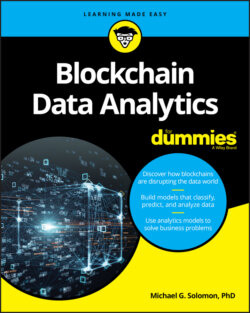Читать книгу Blockchain Data Analytics For Dummies - Michael G. Solomon - Страница 70
Understanding what's stored in blockchain blocks
ОглавлениеAs mentioned in Chapter 2, blockchain is just a specially constructed group of blocks that are linked, or chained, to one another. Each block header contains the hash of the previous block, forming the link that creates the chain. From many descriptions, it sounds like the blocks in a blockchain are pretty much the same as the data in a database or other data repository. However, that view isn’t accurate. Blockchain stores a lot more than just values of data items, which is why blockchain analytics is so interesting. A lot of information is in a blockchain, but you need to know how to get to it.
Each block consists of some header information and a collection of transactions. In most blockchain implementations, miners select the transactions they want to include in blocks. In Ethereum, if a miner is the first to mine that block, he or she selects transactions based on the potential payoff. Other blockchain implementations use different methods to create blocks. Hyperledger Fabric, for example, uses order nodes instead of miners. Because Hyperledger Fabric uses a different consensus mechanism, it doesn’t rely on competing miners to create valid blocks. Hyperledger Fabric is built on a modular design that makes replacing components, including the consensus mechanism, easy. Hyperledger Fabric uses a consensus mechanism called Kafka by default, but that can be changed if desired. Kafka depends on current nodes electing a leader, and that leader has the authority to build blocks of transactions.
